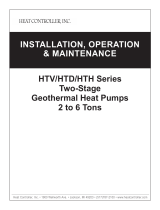
XG-Fan Powered Air Terminals Rev 2 5
Troubleshooting
Investigating Noise Complaints
5Noise from a XG-Fan Powered Air Terminal can be due to a
variety of conditions and can be difficult to eliminate.
5The first step is to isolate the type, source and direction.
5Generally, noise heard at the air outlet is considered a dis-
charge type.
5Noise heard through the ceiling is considered radiated noise.
5For detailed information concerning noise transmission in
buildings, refer to AHRI Standard 885-2008, “Procedure for
estimating occupied space sound levels in the application
of Air Terminals and air outlets”.
Discharge Noise
5This is usually caused by high static or little to no internal duct
lining downstream of the Air Terminal.
5It can sometimes be caused by air outlet itself.
5Air outlet generated sounds can be reduced by reducing flow
or increasing an outlet size.
5Reducing static pressure, flow or adding additional down-
stream attenuation materials will reduce discharge sounds
from the Air Terminal.
Radiated Noise
5Radiated noise is most commonly associated with XG-Fan
Powered Terminals.
5The suspension and the ducting of these XG-Fan Powered
Air Terminals is crucial to minimize any vibrations from being
transmitted through structure or ductwork.
5Severe vibrations or any sounds of knocking or rubbing
should be immediately investigated and the XG-Fan Powered
Air Terminal shut down.
5Occasionally, shipping, handling or installing can
unbalance a blower.
Initial Startup/Adjustment of Fan Flow Rate
1. Check the discharge ductwork is connected.
2. Verify all the electrical connections are properly installed and
that all safety covers and access panels are in place.
3. Inspect the XG-Fan Powered Air Terminal and duct work
for the presence of any packaging or foreign materials and
remove if found.
4. Fan motor is shipped from the factory set at full speed.
5. Allow the motor to warm up for a period of 10 minutes prior
to adjusting the SCR motor speed control.
6. During the warm up period, inspect the ductwork for leaks
and make necessary repairs.
Caution: Do not operate the XG-Fan Powered Air Terminal if
the downstream ductwork is not present.
7. Flow adjustment: Turn the SCR motor speed control counter-
clockwise to reduce the fan speed.
8. Turn the SCR motor speed control clockwise to increase fan
speed.
9. Set the XG-Fan Powered Air Terminal to full heating (maxi-
mum induction).
10. Adjust the downstream dampers (if present).
11. Adjust the SCR motor speed control to deliver the desired
air flow rate by measuring the air delivered to the room outlets
using a flow hood or other instruments.
12. Set the XG-Fan Powered Air Terminal to full cooling (maxi-
mum primary air).
13. The fan speed may need to be readjusted with the primary
air and ventilation at maximum set point to ensure that no
supply air is discharged at the plenum air intake port.
14. Recheck full heating.
Warning: SCR motor speed control will cause all electric
motors to run hotter. Speed reduction should never fall
below 700 RPM for proper lubrication of the bearings/
sleeves.
Fan Motor Maintenance
The fan motor is equipped with permanently lubricated bearings.
Inspect the fan motor, fan and XG-Fan Powered Air Terminal unit
for a buildup of dust or foreign material.Clean as required based
on the operating environment and type of insulation installed.
Fan Startup for Series Constant Volume XG-Fan Powered Air
Terminals
• It is standard operating procedure for Series (Constant
Volume) XG-Fan Powered Air Terminal units to close pri-
mary air damper if the fan is shut off during unoccupied
times.
• Upon morning warm up, the primary air damper should be
closed before the fan is re-energized or restarted to prevent
the fan blower wheel from running backwards.
• Once the fan is running in the proper direction, the primary
damper can be re-opened.
• The reason for this coordination between the primary damper
and fan is due to the Series Constant Volume fan design.
• The fan blower and motor are positioned “in series” with the
primary inlet and any residual primary air traveling through
the XG-Fan Powered Air Terminal can cause the fan blower
wheel to run backwards.
• If the fan blower wheel is rotating backwards at fan startup
and the fan motor is re-energized, this condition results in a
high torque condition which could lead to premature motor
failure.
• It can also loosen the set screw on the fan blower wheel-to-
motor shaft.
• This condition is not a manufacturing defect and thus not
covered under our standard warranty.
• If the control scheme is as described above, the fan blower
wheel set screw should be periodically checked for tightness
and verify that LOCKTITE is applied.










